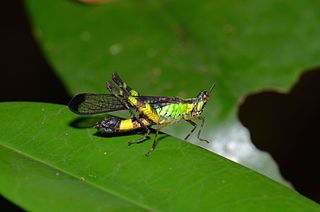
Acrididae, commonly called short-horned grasshoppers, are the predominant family of grasshoppers, comprising some 10,000 of the 11,000 species of the entire suborder Caelifera. The Acrididae are best known because all locusts are of the Acrididae. The subfamily Oedipodinae is sometimes classified as a distinct family Oedipodidae in the superfamily Acridoidea. Acrididae grasshoppers are characterized by relatively short and stout antennae, and tympana on the side of the first abdominal segment.

The subfamily Catantopinae is a group of insects classified under family Acrididae. Genera such as Macrotona may sometimes called "spur-throated grasshoppers", but that name is also used for grasshoppers from other subfamilies, including the genus Melanoplus from the Melanoplinae.

Bandwings, or band-winged grasshoppers, are the subfamily Oedipodinae of grasshoppers classified under the family Acrididae. They have a worldwide distribution and were originally elevated to full family status as the Oedipodidae. Many species primarily inhabit xeric weedy fields, and some are considered to be important locusts:

The grasshopper subfamily Acridinae, sometimes called silent slant-faced grasshoppers, belong of the large family Acrididae in the Orthoptera: Caelifera.

The Romaleidae or lubber grasshoppers are a family of grasshoppers, based on the type genus Romalea. The species in this family can be found in the Americas.

The subfamily Pseudophyllinae contains numerous species in the family Tettigoniidae, the katydids or bush crickets. Sometimes called "true katydids", together with the crickets of suborder Ensifera, they form part of the insect order Orthoptera which also contains grasshoppers.

The Phaneropterinae, the sickle-bearing bush crickets or leaf katydids, are a subfamily of insects within the family Tettigoniidae. Nearly 2,060 species in 85 genera throughout the world are known. They are also known as false katydids or round-headed katydids.

Gomphocerinae, sometimes called "slant-faced grasshoppers", are a subfamily of grasshoppers found on every continent but Antarctica and Australia.

Pyrgomorphidae is a family of grasshoppers in the order Orthoptera; it is the only family in the superfamily Pyrgomorphoidea. Pyrgomorphidae is found worldwide in tropical and warm temperate regions, but the vast majority of the family's approximately 500 species are from Africa, Asia and Australia. Their name is probably derived from pyrgos meaning "tower": a reference to the form (morph) of the head in the type genus Pyrgomorpha and other genera.

Eumastacidae are a family of grasshoppers sometimes known as monkey- or matchstick grasshoppers. They usually have thin legs that are held folded at right angles to the body, sometimes close to the horizontal plane. Many species are wingless and the head is at an angle with the top of the head often jutting above the line of the thorax and abdomen. They have three segmented tarsi and have a short antenna with a knobby organ at the tip. They do not have a prosternal spine or tympanum. Most species are tropical and the diversity is greater in the Old World. They are considered primitive within the Orthoptera and feed on algae, ferns and gymnosperms, the more ancient plant groups.

Oxyinae is subfamily of grasshoppers in the family Acrididae. Species are distributed throughout Africa and Australasia.

Erianthus is a genus of grasshoppers restricted to Southeast Asia. They occur in Japan, northeast India, Myanmar, Thailand, Vietnam, South China including Hong Kong, and extend east to Sumatra. In the past some neotropical species were also included in the genus. They have narrow ranges and species are identifiable only by their characteristics of male and female genitalia.

The Hemiacridinae are a subfamily of Acrididae in the Orthoptera: Caelifera. Species can be found in Africa and Asia.

Romaleinae is a subfamily of lubber grasshoppers in the family Romaleidae, found in North and South America. More than 60 genera and 260 described species are placed in the Romaleinae.

The Pyrgomorphinae are a subfamily of grasshoppers in the family Pyrgomorphidae. Species are found in, especially the warmer parts of: Central and South America, southern Europe, Africa, Asia, Australia and Pacific Islands. The type genus is Pyrgomorpha and names dates from "Pyrgomorphiden" by Brunner von Wattenwyl, 1874. The first use of Pyrgomorphinae was by Krauss in 1890.

Copiocerinae is a subfamily of short-horned grasshoppers in the family Acrididae. There are at least 20 genera in Copiocerinae, found in southern North America, Central America, and South America.

Erucius is a genus of "monkey grasshoppers" in the family Chorotypidae. Species in this genus can be found in Vietnam and Malesia, including the Philippines. It is the only genus in the subfamily Eruciinae.

The Erianthinae are a subfamily of Asian grasshoppers in the family Chorotypidae and based on the type genus Erianthus. There are currently 12 genera and more than 40 described species recorded from southern China, Japan, Indo-China and Malesia.

Chorotypinae is a subfamily of grasshoppers in the family Chorotypidae. There are currently more than 30 described species in Chorotypinae, found in Africa and Asia






















